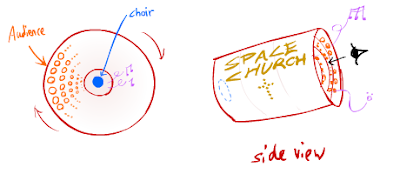Observation told me that only a small fraction of the huge indoor space was being used for the audience - the floor. Gravity-dictate. Unused space existed! Also, there was a lot of empty space in the volume of air above us that could have been used for audience-spaces.
Trying to fix the latter cause (of the space-waste problem) first, I imagined a second floor above the audience, where more seats could be filled. The problem with this hypothetical, of course, was that members further back on the ground level would be obstructed by the new 'ceiling' formed by the second floor.
This could be rectified by lifting the second floor higher, but that would cost the top-floor audience their proper view of the stage. This wasn't good enough. I wanted a solution with no re-allocated costs to the audience.
I imagined antigravity, to simplify things. People could just float around anywhere to view the service at the spatial location of their choosing. Still, in this case, there would inevitably be some people blocking others as they hovered in front of them. Bah!
How would I fix that?
I came to the conclusion that resolving the wastage of space by using the free space within the volume of the room would only be simple if there was some way to render people transparent. Then, people could more efficiently utilise the room as an audience and wouldn't have their view blocked.
But I didn't want to delve into that problem (making people temporarily transparent). So instead I battled with the former cause of the problem - unused surfaces. If other surfaces could be filled, it would cause benefit by adding more audience seats without costing the existing audience their view of the stage (in this case, the choir).
The problem was like a cube. One interior side was being used for the choir, and another side - the bottom - was being used for the audience. If we could fill the other sides with audience, the problem would be greatly lessened.


click to zoom in, by the way.
Now that I think of it, an antigravity-based solution isn't really necessary.. but whatever. I'll continue.
SO.
What popped into mind was that the church hall could instead be a cylindrical shape in a simulated symmetrical gravity. The great cylinder-church would spin to simulate gravity towards the inner surface of the tube. Like a-this:

Way more surface-efficient!
But one last problem. This way, there would be people seeing the choir upside down. To solve this, the choir would have to be organised a different way - a circular arrangement, as opposed to the usual horizontal columns. Their song would resonate through the tube in a circular symmetry.
Then I extrapolated a bit.
Say this structure of building was commonly used in a world where humans habitated space (i.e. in antigravity, woop). for buildings where a large audience was needed in front of a common "message-giver" (a choir, a musical band, a presentation, a talk, etc.) . There would exist a new problem: Text. For all of the people in the circularly-arranged audience to read the same text without tilting their heads at some angle to the side, lots of copies of that same text would have to be made, and arranged in a circle.

Whether this is done with screens or print, the same problem arises: It's pretty costly, especially if all you want to say is one letter (in the case of the illustration, ''A''). The messagers aren't getting much bang for their buck.
Then I thought: A new text/language that could be developed to suit this circular style of presenting a message. One that could be read from all angles of reading. It would have to be read vertically, for all spectators can see the text's "radius", but text lying on the circumference could only be read partially. And would have to scroll I guess. So.. example!

Liddat. Of course a more fluid text, easier to write in a circle, than mine would be developed.
I guess the circle language would have its limitations. The more letters, the more circles, and each letter would have to cover subsequently larger perimeters. So it's limited to shorter texts I suppose.
It was a cool idea in my head though. ._.
Then the thoughts ended there, and I continued paying attention. Woo! But I thought the circular text thing was a pretty neat idea. Had to save it here lest it be lost forever.
Had to get the tablet plugged up to the office to make some of this clear, would've been too confusing otherwise. FinallyI'm touching dearest tablet after SO LONG. WOOOOO
-Zan
No comments:
Post a Comment